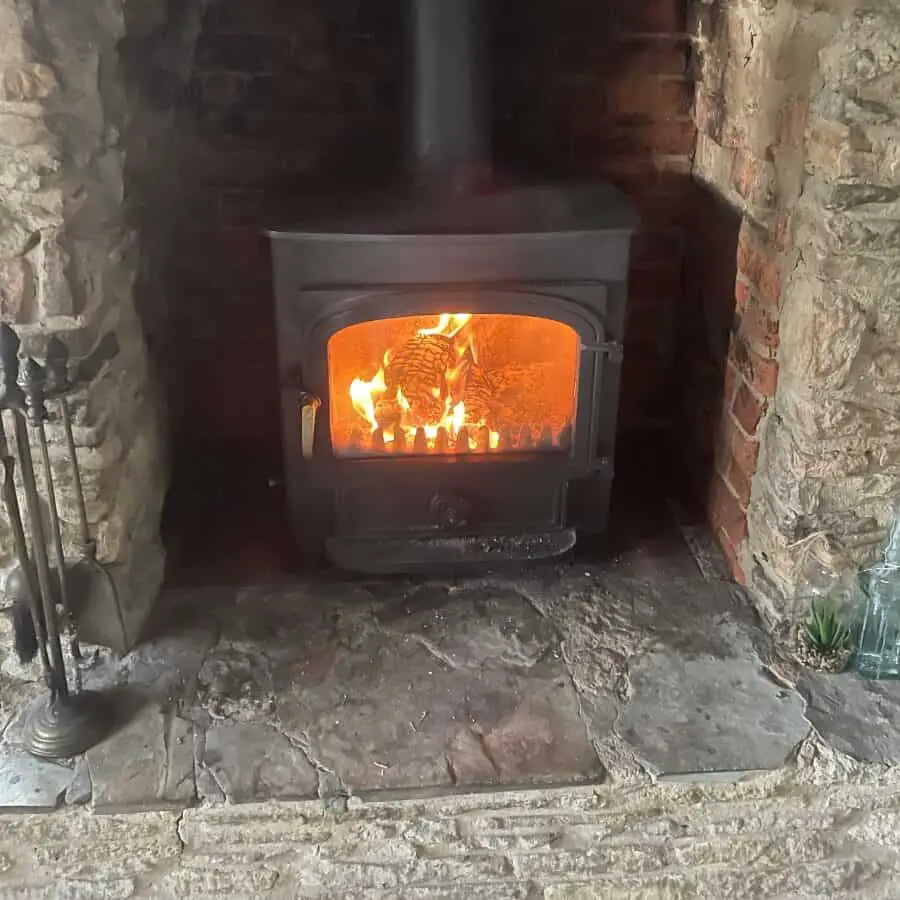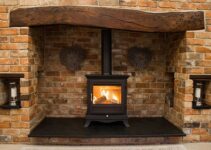As an enthusiast of log burner maintenance, I’m always seeking methods to improve log burner heating and enhance log burner efficiency. Mastering the Extended Burn technique is a cornerstone of ensuring a warm and cosy night.
So how do you keep a log burner going? To keep your log burner going for longer It begins with creating a robust log bed, and keeping the air vents open to provide a sufficient amount of oxygen circulating.
Let’s look at this in more detail!

Arranging large logs in a meticulously tight East-West fashion, and ensuring the wood is seasoned and hardwood, all contribute to a fire that not only lasts all night but does so safely and efficiently. Let me guide you through the ins and outs of achieving an all-night burn that will transform your log burner experience.
Understanding the Extended Burn Technique for Log Burners
The essence of this method lies in meticulously controlling the burn rate through strategic log burner techniques, which include the management of log burner airflow and insulation. Let’s discuss the nuances of this technique that can revolutionise the way you utilise your log burner.
Optimising Wood Loading for Sustained Burning
A symphony of wood, each log meticulously chosen for its girth and dryness, is stacked with precision. For this craft, an “East-West” orientation of the wood is paramount, alongside ensuring the logs are nestled tightly together.
This technique for log burner insulation safeguards against a rapid burnout—imagine a tightly packed battalion, logs shoulder to shoulder, safeguarding each other from being engulfed too soon by the flames. Below is a guide I follow for optimising wood loading.
| Log Size | Orientation | Outcome |
|---|---|---|
| 4-6″ Diameter | East-West | Slow-burning, consistent fire |
| Large logs | East-West | Lasting heat reservoir |
| Smaller logs | East-West | Insulates larger logs |
The Role of Airflow and Insulation in Log Burner Efficiency
The dance of flames within a log burner is one of breath and release—the careful modulation of log burner airflow. Adjusting the stove’s air vents after the logs are set, I find a delicate balance.
A slight opening suffices to feed the fire just enough oxygen to keep it alive but not so much as to hasten its demise. This mastery over airflow, a whisper of the outside world inside the stove, culminates in a stable and efficient burn, reinforcing the effectiveness of log burner insulation.
As the night unfurls into hours of potential cold, I rest assured that the fire will persist. With the logs strategically packed, and airflow meticulously controlled, my log burner stands as a bulwark against the darkness, a sentinel of warmth throughout the wintry night.
Choosing the Right Log Burner Fuel for Overnight Heating
In my years of experiencing the joys and challenges of maintaining a log burner, I’ve come to understand the pivotal role of selecting the appropriate wood for secure and extended overnight heating which you can leave unattended.
Hardwoods like oak, hickory, or pine stand out for their dense structure, conferring upon them an admirable slow-burning quality that is essential for enduring warmth. My advice is underpinned by the fact that these woods have earned their place at the heart of log burner safety, reducing the need for frequent refuelling and minimising risk.

I make sure that the moisture content in the wood stands firmly below the 20% mark, for it is this dryness that ensures a stable burn and a smoke-free environment, well into the depths of the night.
Here, is a comparative table that illustrates the significant differences among various hardwoods that can be used:
| Wood Type | Burning Duration | Moisture Content |
|---|---|---|
| Oak | Long | Below 20% |
| Hickory | Longer | Below 20% |
| Pine | Long, yet faster than Oak/Hickory | Below 20% |
This strategic alignment promotes a consistent burn, capable of withstanding the night without the necessity for my intervention. The result is a fusion of efficiency and log burner safety—a warm and vigilant guardian that stands against the cold night’s surrender to morning.
The selection of wood has a direct and profound impact on the heating efficiency and safety of a log burner, particularly for those cherished overnight burns. It is a practice that I ensure is considered with due diligence and respect for the powerful natural elements at play within the heart of my home.
How do you keep a log burner going all night
Making sure your log burner goes all night long can be achieved through a blend of tried-and-tested approaches and a touch of vigilance, achieving an all-night burn.
Prepping Your Stove Before Bed
The artistry of how you keep a log burner going all night begins hours before bed, as the stove is ignited and left to burn, encouraging a thick bed of ash to form. This bed serves as an insulating layer, a protective foundation whereupon my logs will eventually lie – the guarantee of a flame that will endure till morning’s light.
Strategic Wood Placement
With a fiery canvas of glowing embers cradled at the front of the stove, my task shifts to the careful arrangement of the night’s fuel. The secret to a prolonged embrace of warmth lies in the strategic placement of the wood. By stacking large logs on top , I introduce minimal air gaps, compelling the logs to burn more slowly. The alignment is critical; each piece laid with purpose, creating a tight embrace that conserves the energy of the burn for hours to come.
Choreographing this nightly performance involves the addition of ash from the stove’s ashtray. I sprinkle this fine, grey powder onto the young flames, whispering them into a subdued state. Then, with a measured hand, I moderate the life-giving airflow, tapering the stove’s vents to allow just a hint of oxygen’s zest to feed the simmering glow within.
In this tableau, smaller logs play their part magnificently, huddled around their larger kin at the stove’s rear. Bound together by the very force of their arrangement, they signify a rampart against the cold night – a bulwark formed of oak, of hickory, of pine – standing united in their singular purpose to sustain the burn for 6 to 8 sound hours.
Essential Log Burner Safety Checks for a Worry-Free Night
I integrate stringent log burner safety and maintenance practices into my routine so that the log burner is safe to leave.
The serenity of sleep should never be compromised by concerns of safety; therefore, I remove any flammable materials from the vicinity of the stove before initiating the overnight burn. It’s an essential, yet simple measure of precaution that significantly reduces the risk of accidental ignitions. This practice, coupled with the proper regulation of the fire, lays the foundation for a restful night assured by the reliable and secure operation of my log burner.
Once the embrace of the night gives way to dawn, and the log burner has faithfully performed its role, I attend to the final, but equally critical, task of ash disposal. This ensures that my stove is ready to meet the challenges of another night, safeguarding my home’s comfort and security.
FAQ
How do I keep my log burner going all day?
Log burner maintenance for an all-night burn includes ensuring the log burner is clean, the chimney is swept regularly, and that the air vents are free from obstruction. Before initiating the Extended Burn Technique, build a proper log bed, load the wood effectively, and adjust airflow to optimise burning efficiency and safety.
Can you explain the Extended Burn Technique for log burners?
The Extended Burn Technique involves creating a robust log bed by raking embers to the front of the stove, then strategically placing hardwood logs on top orientated East-West. By maintaining a compact arrangement and partially closing the air vents, you can achieve a slow, consistent burn that can last through the night with minimal vent adjustments.
What is the most effective way to load wood to keep my log burner going all night?
For effective wood loading, place large, seasoned hardwood logs compactly on top. Ensure the logs are parallel to the door (East-West), avoiding a crisscross pattern to slow the burn rate. The wood should be stacked tightly with fewer air gaps to promote a prolonged and even burn.
How crucial is airflow and insulation for log burner efficiency?
Airflow and insulation are vital for log burner efficiency. Proper airflow can be controlled by partially closing the air vents to reduce oxygen, thereby slowing down combustion. Insulation, such as using a heat reflector or maintaining airtight seals, helps to retain heat longer and makes the burning process more efficient.
What type of fuel should I use in my log burner for overnight heating?
For overnight heating, use seasoned non-resinous hardwoods like oak or hickory, as they burn slower and hotter. Ensure the logs are dry with a moisture content below 20% for an efficient and safe burn. This will provide a steady source of heat throughout the night, reducing the need for reloads.
How do you prepare your log burner before going to bed to ensure it burns all night?
To prepare your log burner before bed, allow the fire to burn down to a thick bed of kindling, then add a few large hardwood logs behind them, east to west. Just before retiring, distribute the embers, close the stove’s vents to restrict airflow. These steps should help maintain a consistent burn throughout the night.
What are the essential safety checks for a worry-free night with a log burner?
Essential safety checks include making sure the log burner is in good condition, the chimney and flue are clean and clear of blockages, and combustible materials are clear of the stove’s vicinity. Always initiate the overnight burn with a controllable fire and ensure that the ash is disposed of correctly the following morning for safety and readiness for the next use.



